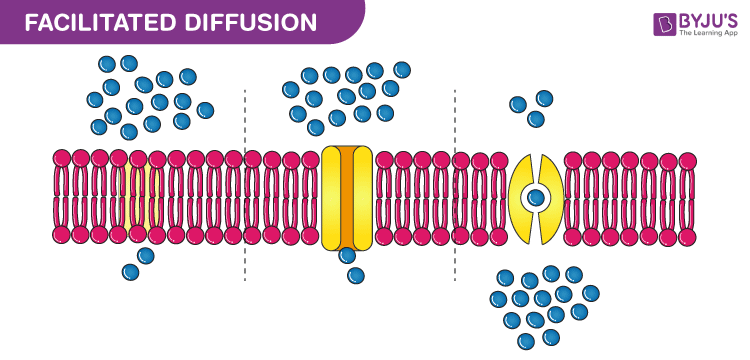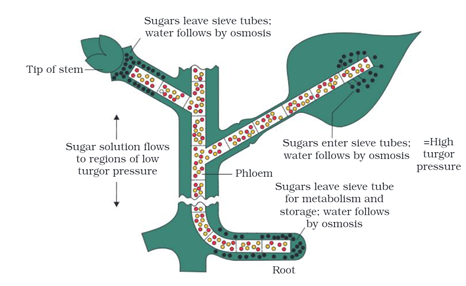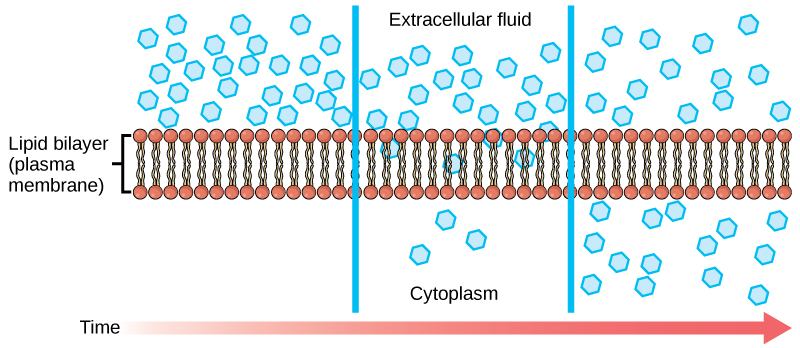CBSE Class 11 Biology Chapter 11 Revision Notes
Chapter 11: Transport in Plants Revision Notes
Multiple Choice Questions
-
The only mode of gaseous movement in the plant body is.
-
If two types of molecules move together in opposite directions, identify the type of transport.
-
Where are porins present?
-
Osmosis is diffusion of water across a.
-
Which of the following help move substances across membranes in facilitated diffusion?
-
Which of the following transport mechanisms is not highly selective?
-
What happens when a plant cell is put in hypotonic solution?
-
Transpiration increases with an increase in .
-
Phloem sap is mainly composed of
-
Where is the control point for minerals, where a plant adjusts the quantity and types of solutes that reach the xylem?
Transport in Plants
- Transportation in plants is conducted through tissues for carrying water, nutrients, and minerals.
- Transportation of these nutrients over short distances occurs through diffusion and is commonly seen in flowering plants
- Long-distance transfer of nutrients via the vascular system (xylem and phloem) is known as translocation and is commonly observed in the cases of tall trees.
- Translocation can be unidirectional , as in the case of water from the roots to the stems, or multidirectional , as in the case of minerals and organic solutes.
Means of Transport
Diffusion
Diffusion is a slow process and is not dependent on energy sources.
Substances typically move from areas of high concentration to areas of low concentration.
It is the only means for gaseous movement within the plant body
Rate of diffusion is determined by :
- Concentration gradient
- Membrane permeability
- Temperature
- Pressure
Facilitated Diffusion
Diffusion of substances majorly depends on its solubility in lipids (lipids are a major membrane component).
As expected, lipid solubility is an important advantage for substances to pass through the cell membrane.
- Lipid soluble particles pass through the cell membrane readily, whereas the passage of hydrophilic solutes is aided.
- Membranes with aquaporins or water channels enhance diffusion.
- Aquaporins are membrane proteins that allow water-soluble compounds to be transported without the need for energy.
- The protein creates channels in the membrane through which chemicals can travel.
- Porins are proteins that produce massive holes in the outer membranes of plastids, mitochondria, and other organisms.
- Aquaporins are eight distinct types of proteins that make up water channels.
Thus in facilitated diffusion , special proteins help move substances across membranes without expenditure of ATP energy.
Some carriers allow diffusion of molecules only in pairs!
- Symport: Both molecules cross the membrane in the same way
- Antiport: Both molecules travel in the opposing direction
- Uniport: Occurs when a molecule passes across a membrane without the help of other molecules.

Active Transport:
- Pumps molecules against a concentration gradient using energy.
- Membrane proteins are responsible for this.
- Pumps are mobile carrier proteins that are used in active transport.
- Pumps are capable of transporting substances from low to high concentrations.
- What the carrier proteins carry across the membrane is quite specialized.
Plant-Water Relations
Water makes up the plant cell protoplasm with dissolved molecules.
Transpiration is loss of water from the leaves through evaporation.
Water potential:
- Pure water has the greatest water potential or Ψw.
- Water potential is expressed in pressure units such as pascals (Pa).
- All solutions have a lower water potential than pure water.
- The magnitude of this lowering due to dissolution of a solute is called solute potential or Ψs
- Turgidity increases the pressure potential or Ψp
- Movement of water in plants is driven by negative pressure potential or tension in the water column in the xylem.
- Ψw = Ψs + Ψp
Osmosis:
-
Osmosis is the transport of molecules through a semipermeable membrane from a greater concentration location to a lower concentration region until equilibrium is attained.
-
The net direction and rate of osmosis depends on both the pressure gradient and concentration gradient.
-
The plant cell wall allows chemicals in solution and water to pass easily. There are two forms of osmosis:
-
When a cell is put in a hypotonic solution, endosmosis occurs, which is the transport of water molecules into the cell.
-
When a cell is put in a hypertonic solution, exosmosis occurs, which is the migration of water molecules out of the cell.
Plasmolysis:
- Plasmolysis happens when the water leaves the cell, and the cell membrane shrinks away from the cell wall of a plant cell.
- When a cell (or tissue) is put in a solution that is hypertonic (higher in solutes) than the protoplasm, this happens.
- Water escapes the cell, first from the cytoplasm, then from the vacuole.
- The process of plasmolysis is usually reversible and turgor pressure can be rebuilt.
Imbibition:
- Occurs when water is absorbed by solids and causes them to expand in volume.
- Examples include water absorption by seeds and dry wood.
- Classified as a type of diffusion since a water potential gradient is essential between the absorbent and the liquid.
- Affinity between the adsorbent and liquid is necessary.
How do Plants Absorb Water?
The main tissue responsible for water transport in plants is the xylem.
- A mass or bulk flow system generally moves water, minerals, and food.
- The bulk movement of substances through the conducting or vascular tissues of plants is called translocation.
- Once water is absorbed by the root hairs via diffusion, it can move deeper into root layers by two distinct pathways:
- apoplast pathway: movement of water occurs exclusively through the intercellular spaces and the walls of the cells (mass flow and gradient dependant).
- symplast pathway : water travels through the cells – their cytoplasm; intercellular movement is through the plasmodesmata.
- Mycorrhiza is a symbiotic association of a fungus with a root system that helps increase the water absorbed (large surface area) in exchange for sugars and N-containing compounds from the plant cell.
Water movement In Plants
ROOT PRESSURE
- When ions in the soil are actively carried into the vascular tissues of the roots, positive pressure called root pressure is created inside the roots.
- It is responsible for pushing up water to small heights in the stem.
- Majorly helps to re-establish the continuous chains of water molecules in the xylem (broken due to the enormous tensions created by transpiration).
- At night, guttation (water loss in its liquid phase) occurs when the rate of evaporation is low and excess water in the form of water droplets is noticed towards the tips of the leaves.
TRANSPIRATION PULL
- Transpiration pull is the force that propels water upward. Dixon and Jolly presented the cohesion-tension theory to explain the upward flow of water in plants.
- The stomata is responsible for transpiration and gas exchange.
- The turgidity and the orientation of the microfibrils in the cell walls of the guard cells regulates the opening and closing of the stomatal aperture.
- Transpiration is affected by temperature, light, humidity, wind speed, number and distribution of stomata, per cent of open stomata, water status of the plant, and canopy structure.
- Cohesion is the term for the attraction between water molecules.
- Adhesion is the term for attracting water molecules to other polar molecules.
- Another feature that boosts transpiration pull is surface tension. Surface tension refers to the attraction between water molecules in the liquid phase more than to water in the gas phase.
- These properties give water high tensile strength , i.e., an ability to resist a pulling force, and high capillarity , i.e., the ability to rise in thin tubes (the tracheids and vessel elements).
- During transpiration, water is lost, resulting in negative pressure in the xylem vessels. The phenomenon is known as transpiration pull.
- Transpiration also helps in:
- Photosynthesis water supply
- Mineral transport from the soil to all parts of the plant
- Evaporative cooling
- Maintaining cells turgidity
UPTAKE AND TRANSPORT OF MINERAL NUTRIENTS
Mineral transport in Plants:
- Plant roots absorb minerals in two ways: passively and aggressively.
- Because ions are charged and cannot pass the membrane without burning energy, the bulk of transport happens actively (active absorption into the cytoplasm of epidermal cells).
- Energy is provided through ATP. Sucrose, a photosynthetic end product, is transferred from the source (where synthesis takes place, such as leaves) to the sink (organs that store food).
- Water transfer is unidirectional , but food or sugar transmission is bidirectional.
- Transport proteins of endodermal cells are control points, where a plant adjusts the quantity and types of solutes that reach the xylem.
Translocation of Mineral Ions
- The transpiration stream then picks up the ions absorbed by the xylem.
- The growing regions of the plant are the major sinks (fine vein endings).
- Elements such as phosphorus, sulphur, nitrogen and potassium are moved from older, senescing parts to the younger leaves.
PHLOEM TRANSPORT: FLOW FROM SOURCE TO SINK
The main **tissue responsible for food (sucrose) transport/translocation in higher plants is the phloem.
- Here the sink and source can be reversed (sugar in roots during spring to nourish the buds).
- Movement in the phloem can be upwards or downwards , i.e., bi-directional.
- The phloem sap comprises mainly water and sucrose , but other sugars, hormones and amino acids too.
The Pressure Flow or Mass Flow Hypothesis
- The pressure-flow theory, mass flow hypothesis, or Munch hypothesis was developed for sugar translocation from source to sink.
- The phloem is responsible for this. Phloem comprises sieve tubes, companion cells, and phloem parenchyma.
- Glucose produced by photosynthesis converted to sucrose and is used as food by the plants.
- Food is actively transported from source to sink via sieve tubes and companion cells.
- Sugars are put into a sieve tube passing through the phloem , starting at the source.
- The hypertonic environment created by loading sieve tubes allows water to reach the phloem.
- The food/sucrose goes towards the sink due to the strong osmotic pressure at the source (with low osmotic pressure).
- As a result, osmotic pressure is thought to be the driving force behind food migration from the source to the sink.
- Active transport moves the sugars from the phloem sap into the cells.

Sources: Phloem transportation in plants
]]>
